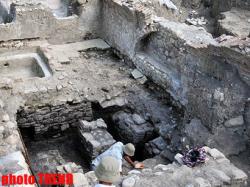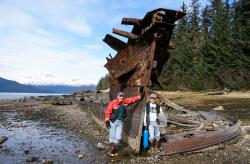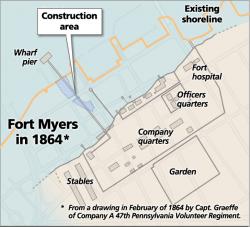INSTITUT SUPERIEUR D'ANTHROPOLOGIE
INSTITUTE OF ANTHROPOLOGY
ONLINE COURSES / COURS A DISTANCE
INSCRIPTION 2012 / Session III : Juillet 2012
REGISTRATION 2012 / Term III : July 2012
AZERBAIDJAN –  Shahriyar - During archaeological research conducted by the Institute of Archeology and Ethnography in the Bilasuvar region, ancient monuments and an ancient city were found, Institute of Archeology and Ethnography employee Arif Mammadov said on Thursday. He said that on Thursday during archaeological excavations in the Bilasuvar region the expedition identified 'Chel Aghdam', 'Isheri Aghdam' rocks, the ruins of the medieval town of Shahriyar, and medieval settlement and other archaeological objects were found in the villages of Samedabad and Ismetli. Until now, there was information about the town of Shahriyar, but in this connection no archaeological excavations were conducted, Mammadov said. The historian said the materials associated with this town, as well as other monuments identified, were transferred to Bilasuvar Historical Museum. In the coming days excavations will begin on the identified areas. At the present time the area of archaeological excavations is being determined, he said.
Shahriyar - During archaeological research conducted by the Institute of Archeology and Ethnography in the Bilasuvar region, ancient monuments and an ancient city were found, Institute of Archeology and Ethnography employee Arif Mammadov said on Thursday. He said that on Thursday during archaeological excavations in the Bilasuvar region the expedition identified 'Chel Aghdam', 'Isheri Aghdam' rocks, the ruins of the medieval town of Shahriyar, and medieval settlement and other archaeological objects were found in the villages of Samedabad and Ismetli. Until now, there was information about the town of Shahriyar, but in this connection no archaeological excavations were conducted, Mammadov said. The historian said the materials associated with this town, as well as other monuments identified, were transferred to Bilasuvar Historical Museum. In the coming days excavations will begin on the identified areas. At the present time the area of archaeological excavations is being determined, he said.
http://en.trend.az/news/society/2032381.html#popupInfo
ROYAUME UNI  Upton - An unusual collection of pottery which was dumped in a ditch on the edge of Northampton 2,000 years ago has left archaeologists bemused. The pots, some of which come from Europe, were unearthed on the edge of the new Upton village during an archaeological dig this week. Archaeologist, Liz Muldowney, who is leading the dig, said it was not yet clear why the pots, which are well preserved, had been buried on the site. She said: “We don’t know why the pottery is here, but it suggests there was a house of reasonably high status nearby. “It’s certainly very unusual to find a collection of pottery together like this. “Sometimes it’s associated with people moving home – they deliberately throw away their pottery when they leave. But they’ve quite deliberately thrown away some very expensive items. For farmers to be able to afford pottery that’s come from France represents a significant part of their limited wealth.” Previous excavations on the land have revealed the site, which is close to Weedon Road, was populated during the Iron Age and early Roman period. Mrs Muldowney said: “The dig has proved this wasn’t an urban area, it’s agricultural land outside the old Roman town of Duston. “We’ve got stock enclosures from the early Roman period, showing they’ve been using
this land for farming and living on. “It’s hard to tell how many people would have lived here, but it’s likely to be extended families and there could have been 20 to 40 people here in the Iron Age.” The pottery which was found in the ditch included valuable samian ware which dates form the early Roman period. Buried alongside it were a plate, a storage jar and a small dish.
Upton - An unusual collection of pottery which was dumped in a ditch on the edge of Northampton 2,000 years ago has left archaeologists bemused. The pots, some of which come from Europe, were unearthed on the edge of the new Upton village during an archaeological dig this week. Archaeologist, Liz Muldowney, who is leading the dig, said it was not yet clear why the pots, which are well preserved, had been buried on the site. She said: “We don’t know why the pottery is here, but it suggests there was a house of reasonably high status nearby. “It’s certainly very unusual to find a collection of pottery together like this. “Sometimes it’s associated with people moving home – they deliberately throw away their pottery when they leave. But they’ve quite deliberately thrown away some very expensive items. For farmers to be able to afford pottery that’s come from France represents a significant part of their limited wealth.” Previous excavations on the land have revealed the site, which is close to Weedon Road, was populated during the Iron Age and early Roman period. Mrs Muldowney said: “The dig has proved this wasn’t an urban area, it’s agricultural land outside the old Roman town of Duston. “We’ve got stock enclosures from the early Roman period, showing they’ve been using
this land for farming and living on. “It’s hard to tell how many people would have lived here, but it’s likely to be extended families and there could have been 20 to 40 people here in the Iron Age.” The pottery which was found in the ditch included valuable samian ware which dates form the early Roman period. Buried alongside it were a plate, a storage jar and a small dish.
http://www.northamptonchron.co.uk/news
SUEDE - Verke Å - Swedish archaeologists believe they have discovered the world's oldest wooden fishing equipment on the Baltic Sea floor of the coast of southern Sweden. The find, located of the eastern coast of Skåne County, consists of an arrangement of several finger-width sticks dated to be 9,000 years old. Archaeologists believe the sticks were woven or tied together with rope into fence-like structures and then placed in the river to guide fish into nets or other containers. The discovery was made in a floodway which used to be part of the Verke River (Verke Å). Today the area is submerged beneath the surface of the Baltic Sea, but 9,000 years ago, the floodway was above sea level. In addition to the fishing equipment, archaeologists have also found leftover food and other waste likely thrown in the river by early residents. However, no settlements have yet been uncovered, according to Rönnby. The discovery was made as part of a larger research project carried out by the MARIS maritime archaeology institute at Södertörn dubbed Landscapes Lost. Launched in 2011, the project aims to survey and examine the postglacial river mouth of Verke river's well as the archipelago off of Blekinge in southern Sweden. Researchers hope their work will shed light on how people lived and what the now-underwater landscape looked like 9,000 years ago.
http://www.thelocal.se/41256/20120605/
USA –  Alaska - The Alaska Office of History and Archaeology estimates there could be as many as 3,000 shipwrecks lining the state’s 44,000 miles of coastline. Now, the multi-million-dollar mystery behind one of those wrecks may finally be answered, when a Seattle-based company attempts to salvage the remains of the SS Islander, which sank in 1901 while carrying Klondike gold rushers – and, reportedly, lots of their gold -- from Skagway to the city of Victoria in British Columbia. Built in 1888 in Glasgow at a cost of about $200,000, the 240-foot-long vessel was a model of late 19th-century luxury, built specifically for northern waters. Like the more famous Titanic, many presumed the ship to be “unsinkable,” constructed with airtight compartments that could flood individually without the entire ship sinking. The Islander operated during the peak of the Klondike Gold Rush in the late 1890s, plying the waters of Southeast Alaska as the region saw a huge influx of hopeful prospectors seeking their fortunes. The treacherous waters of the Alaska Panhandle, combined with the heightened shipping traffic, claimed more than a few vessels. On the night of August 14, 1901, the Islander departed Skagway with 180 people aboard and made its way down Lynn Canal. At about 2 a.m., the ship was positioned between Douglas and Admiralty Islands when it struck what was likely either an uncharted rock or a sizeable iceberg. The 1992 report says that a former captain of the vessel believed it was likely an iceberg, which first punctured the hull before being submerged and rising to punch another hole in the vessel toward the stern. The ship reportedly sank a mere 20 minutes after initial impact. About 40 people went down with the ship, though that number may be higher due to a reported 11 stowaways on board who weren’t accounted for. Others rowed lifeboats to Douglas Island, walking to the mining community of Treadwell to inform the world of the tragedy. Given the timeline of the vessel’s sinking and the origin of its passengers, speculation began immediately that the Islander had gone down with a substantial quantity of gold aboard. Numbers vary, but if there were any truth to them, the value of the gold would be extremely high, then and now. One estimate from the “Inventory and Survey of Historic Shipwreck Sites” reports: It was rumored that the steamer’s purser had $275,000 in his safe and that the passengers had another $100,000 with them. Other rumors were that over a quarter of a million dollars in gold went down with the ship. This was at a time when gold was worth $20.67 an ounce. Fifty ounces of gold were found on one body. Another passenger was reported to have taken aboard about 600 ounces of dust. Some $250,000 worth of gold at $20.67 per ounce breaks down to 12,100 ounces of gold rumored to be aboard the Islander when it sank. At today’s prices of around $1,500 per ounce -- a conservative number -- there could potentially be more than $18 million of gold somewhere on Southeast Alaska’s sea floor.
Alaska - The Alaska Office of History and Archaeology estimates there could be as many as 3,000 shipwrecks lining the state’s 44,000 miles of coastline. Now, the multi-million-dollar mystery behind one of those wrecks may finally be answered, when a Seattle-based company attempts to salvage the remains of the SS Islander, which sank in 1901 while carrying Klondike gold rushers – and, reportedly, lots of their gold -- from Skagway to the city of Victoria in British Columbia. Built in 1888 in Glasgow at a cost of about $200,000, the 240-foot-long vessel was a model of late 19th-century luxury, built specifically for northern waters. Like the more famous Titanic, many presumed the ship to be “unsinkable,” constructed with airtight compartments that could flood individually without the entire ship sinking. The Islander operated during the peak of the Klondike Gold Rush in the late 1890s, plying the waters of Southeast Alaska as the region saw a huge influx of hopeful prospectors seeking their fortunes. The treacherous waters of the Alaska Panhandle, combined with the heightened shipping traffic, claimed more than a few vessels. On the night of August 14, 1901, the Islander departed Skagway with 180 people aboard and made its way down Lynn Canal. At about 2 a.m., the ship was positioned between Douglas and Admiralty Islands when it struck what was likely either an uncharted rock or a sizeable iceberg. The 1992 report says that a former captain of the vessel believed it was likely an iceberg, which first punctured the hull before being submerged and rising to punch another hole in the vessel toward the stern. The ship reportedly sank a mere 20 minutes after initial impact. About 40 people went down with the ship, though that number may be higher due to a reported 11 stowaways on board who weren’t accounted for. Others rowed lifeboats to Douglas Island, walking to the mining community of Treadwell to inform the world of the tragedy. Given the timeline of the vessel’s sinking and the origin of its passengers, speculation began immediately that the Islander had gone down with a substantial quantity of gold aboard. Numbers vary, but if there were any truth to them, the value of the gold would be extremely high, then and now. One estimate from the “Inventory and Survey of Historic Shipwreck Sites” reports: It was rumored that the steamer’s purser had $275,000 in his safe and that the passengers had another $100,000 with them. Other rumors were that over a quarter of a million dollars in gold went down with the ship. This was at a time when gold was worth $20.67 an ounce. Fifty ounces of gold were found on one body. Another passenger was reported to have taken aboard about 600 ounces of dust. Some $250,000 worth of gold at $20.67 per ounce breaks down to 12,100 ounces of gold rumored to be aboard the Islander when it sank. At today’s prices of around $1,500 per ounce -- a conservative number -- there could potentially be more than $18 million of gold somewhere on Southeast Alaska’s sea floor.
http://www.alaskadispatch.com/article/does-alaska-shipwreck-hold-millions-gold-rush-riches
USA -  Fort Myers - A $5.3 million construction project on Fort Myers’ historic riverfront should have come to a halt weeks ago, some say. Confederate and Union troops fought one of the southernmost battles of the Civil War a cannonball shot from where backhoes rumble today, resculpting the shoreline that’s long been key to the city’s economy and identity. First the site of a sprawling military complex, it later became a commercial nexus. Most major streets had wharves jutting into the river complete with packinghouses, steamer terminals, railways and businesses. So it’s not surprising that although major digging hasn’t yet begun, old objects are already turning up: a Ford Model A engine block, horseshoes, cologne bottles, chunks of historic seawalls, carriage springs and more. “While the artifacts coming from the fill material are not beautiful examples of early 20th-century material culture because they’re rusted and broken, they are examples of the kinds of things people were using and then discarding in Fort Myers in the early 20th century,” says Snapp, Southwest regional director of the Florida Public Archaeology Network.
Fort Myers - A $5.3 million construction project on Fort Myers’ historic riverfront should have come to a halt weeks ago, some say. Confederate and Union troops fought one of the southernmost battles of the Civil War a cannonball shot from where backhoes rumble today, resculpting the shoreline that’s long been key to the city’s economy and identity. First the site of a sprawling military complex, it later became a commercial nexus. Most major streets had wharves jutting into the river complete with packinghouses, steamer terminals, railways and businesses. So it’s not surprising that although major digging hasn’t yet begun, old objects are already turning up: a Ford Model A engine block, horseshoes, cologne bottles, chunks of historic seawalls, carriage springs and more. “While the artifacts coming from the fill material are not beautiful examples of early 20th-century material culture because they’re rusted and broken, they are examples of the kinds of things people were using and then discarding in Fort Myers in the early 20th century,” says Snapp, Southwest regional director of the Florida Public Archaeology Network.
http://www.news-press.com/article/20120605/NEWS0110/306050003/Exclusive-History-uncovered-along-Fort-Myers-riverfront
USA –  San Jose - Today a circle of palm trees greets visitors approaching the Fairmont Hotel in downtown San Jose. But 125 years ago at the same spot, you might have seen shocked Chinese immigrant families sifting through the burned rubble of their lives. An arson fire in May 1887 destroyed San Jose's first Chinatown, which at the time was the largest Chinese community in the country outside San Francisco. City officials scraped away the ruins and buried most evidence of the community for nearly 100 years. Now the San Jose Institute of Contemporary Art is exhibiting the most important collection of artifacts ever displayed publicly from Market Street Chinatown, as the former community at Market and San Fernando streets is known. The small but significant "City Beneath the City" exhibit includes dozens of archaeologists' finds, including ceramic housewares, tiny green toiletry bottles, toothbrush handles, and pieces of toys and leather shoes that survived a century of abandonment.
San Jose - Today a circle of palm trees greets visitors approaching the Fairmont Hotel in downtown San Jose. But 125 years ago at the same spot, you might have seen shocked Chinese immigrant families sifting through the burned rubble of their lives. An arson fire in May 1887 destroyed San Jose's first Chinatown, which at the time was the largest Chinese community in the country outside San Francisco. City officials scraped away the ruins and buried most evidence of the community for nearly 100 years. Now the San Jose Institute of Contemporary Art is exhibiting the most important collection of artifacts ever displayed publicly from Market Street Chinatown, as the former community at Market and San Fernando streets is known. The small but significant "City Beneath the City" exhibit includes dozens of archaeologists' finds, including ceramic housewares, tiny green toiletry bottles, toothbrush handles, and pieces of toys and leather shoes that survived a century of abandonment.
http://www.mercurynews.com/museums-galleries/ci_20760954/artifacts-exhibited-from-long-buried-san-jose-chinatown
CHINE - Xingtai - Archaeologists have discovered six kilns that date back to the Sui Dynasty (581-618) and Tang Dynasty (618-907) in the city of Xingtai in north China's Hebei province. Excavation work has revealed the tops of three of the kilns, which were discovered in Neiqiu county, according to Wang Huimin, an archaeologist from the Cultural Relics Institute of Hebei. Wang said tools and large amounts of glazed china were also found near the kilns. Many ancient kilns and related relics have been discovered in the county since the early 1950s. Kiln technology first emerged in China during the late South-North Dynasty (420-581), with usage peaking during the Tang Dynasty. The fine white china produced in the kilns was kept in royal palaces and exported to more than 10 countries and regions.
http://www.kaogu.cn/en/detail.asp?ProductID=3494